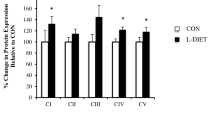Abstract
Abdominal obesity increases the incidence of cardiac events but reduces mortality when one of these events occurs. The phenomenon called obesity paradox might be related to myocardial energetics. This study was aimed at determining whether long-term abdominal adiposity alters cardiac energy function. Two groups of male Wistar rats were fed a standard or a Western-type (WD) diet for 8 months. The ex vivo coronary reactivity and mechanical function as well as the mitochondrial oxidative phosphorylation (mOxPhos) and hydrogen peroxide release (mH2O2r) were determined. Abdominal adiposity was augmented by the WD. This was also the case for the coronary reactivity to acetylcholine, but the rate pressure product remained roughly stable despite a reduction of the left ventricle-developed pressure partly compensated by a slight increase in heart rate. The prolonged WD administration resulted in an improvement of mOxPhos, but the mH2O2r was exaggerated which was confirmed in the whole cell by a reduced aconitase to fumarase ratio. This did not modify the plasma oxidative stress due to an increased plasma antioxidant status. In conclusion, long-term WD administration improved the cardiac fitness and might predispose the organism to the obesity paradox. Conversely, the increased mitochondrial mH2O2r can precipitate the heart toward cardiomyopathy if the WD is maintained for a longer duration.





Similar content being viewed by others
References
Ascensão A, Lumini-Oliveira J, Oliveira PJ, Magalhães J (2011) Mitochondria as a target for exercise-induced cardioprotection. Curr Drug Targets 12:860–871
Bergmeyer HU, Gawehn K, Williamson DH, Lund P (1974) Methods of enzymatic analysis. Academic Press, Weinheim, New-York, London
Faloona GR, Srere PA (1969) Escherichia coli citrate synthase. Purification and the effect of potassium on some properties. Biochemistry 8:4497–4503
Favier AE (1995) Analysis of free radicals in biological systems. Birkhauser Verlag, Basel
Gardner PR, Nguyen DD, White CW (1994) Aconitase is a sensitive and critical target of oxygen poisoning in cultured mammalian cells and in rat lungs. Proc Nat Acad Sci USA 91:12248–12252
Grant RW, Dixit VD (2015) Adipose tissue as an immunological organ. Obesity 23:512–518
Günzler WA, Kremers H, Flohé L (1974) An improved coupled test procedure for glutathione peroxidase (EC 1-11-1-9-) in blood. Zeit Klin Chem Klinische Biochem 12:444–448
Habbout A, Guenancia C, Lorin J, Rigal E, Fassot C, Rochette L, Vergely C (2013) Postnatal overfeeding causes early shifts in gene expression in the heart and long-term alterations in cardiometabolic and oxidative parameters. PLoS One 8, e56981
Horwich TB, Fonarow GC, Hamilton MA, MacLellan WR, Woo MA, Tillisch JH (2001) The relationship between obesity and mortality in patients with heart failure. J Am Coll Cardiol 38:789–795
Jebelovszki E, Kiraly C, Erdei N, Feher A, Pasztor ET, Rutkai I, Forster T, Edes I, Koller A, Bagi Z (2008) High-fat diet-induced obesity leads to increased NO sensitivity of rat coronary arterioles: role of soluble guanylate cyclase activation. Am J Physiol 294:H2558–H2564
Katragadda S, Arora RR (2010) Role of angiotensin-converting enzyme inhibitors in vascular modulation: beyond the hypertensive effects. Am J Ther 17:e11–e23
Kenchaiah S, Evans JC, Levy D, Wilson PW, Benjamin EJ, Larson MG, Kannel WB, Vasan RS (2002) Obesity and the risk of heart failure. N Engl J Med 347:305–313
Kilkenny C, Browne WJ, Cuthill IC, Emerson M, Altman DG (2012) Improving bioscience research reporting: the ARRIVE guidelines for reporting animal research. Osteoarthr Cartil 20:256–260
Lambert GW, Straznicky NE, Lambert EA, Dixon JB, Schlaich MP (2010) Sympathetic nervous activation in obesity and the metabolic syndrome--causes, consequences and therapeutic implications. Pharmacol Ther 126:159–172
Lavie CJ, De Schutter A, Patel DA, Romero-Corral A, Artham SM, Milani RV (2012) Body composition and survival in stable coronary heart disease: impact of lean mass index and body fat in the “obesity paradox”. J Am Coll Cardiol 60:1374–1380
Lavie CJ, De Schutter A, Patel DA, Milani RV (2013) Does fitness completely explain the obesity paradox? Am Heart J 166:1–3
Lopaschuk GD, Ussher JR, Folmes CD, Jaswal JS, Stanley WC (2010) Myocardial fatty acid metabolism in health and disease. Physiol Rev 90:207–258
Mourmoura E, Leguen M, Dubouchaud H, Couturier K, Vitiello D, Lafond JL, Richardson M, Leverve X, Demaison L (2011) Middle age aggravates myocardial ischemia through surprising upholding of complex II activity, oxidative stress, and reduced coronary perfusion. Age (Dordr) 33:321–336
Mourmoura E, Vial G, Laillet B, Rigaudière JP, Hininger-Favier I, Dubouchaud H, Morio B, Demaison L (2013) Preserved endothelium-dependent dilatation of the coronary microvasculature at the early phase of diabetes mellitus despite the increased oxidative stress and depressed cardiac mechanical function ex vivo. Cardiovasc Diabetol 12:49
Mourmoura E, Chaté V, Couturier K, Laillet B, Vial G, Rigaudiere JP, Morio B, Malpuech-Brugère C, Azarnoush K, Demaison L (2014) Body adiposity dictates different mechanisms of increased coronary reactivity related to improved in vivo cardiac function. Cardiovasc Diabetol 13:54
Nuutinen EM (1984) Subcellular origin of the surface fluorescence of reduced nicotinamide nucleotides in the isolated perfused rat heart. Basic Res Cardiol 79:49–58
Skrzypiec-Sprin M, Grotthus B, Szelag A, Schulz R (2007) Isolated heart perfusion according to Langendorff—still viable in the new millennium. J Pharmacol Toxicol Meth 55:113–126
Wannamethee SG, Shaper AG, Whincup PH, Lennon L, Papacosta O, Sattar N (2014) The obesity paradox in men with coronary heart disease and heart failure: the role of muscle mass and leptin. Int J Cardiol 171:49–55
Acknowledgments
The work was supported by the French National Institute of Agronomical Research (INRA), National Institute of Health and Medical Research (INSERM), and Joseph Fourier University of Grenoble.
Author information
Authors and Affiliations
Corresponding author
Rights and permissions
About this article
Cite this article
Mourmoura, E., Rigaudière, JP., Couturier, K. et al. Long-term abdominal adiposity activates several parameters of cardiac energy function. J Physiol Biochem 72, 525–537 (2016). https://doi.org/10.1007/s13105-015-0427-7
Received:
Accepted:
Published:
Issue Date:
DOI: https://doi.org/10.1007/s13105-015-0427-7




